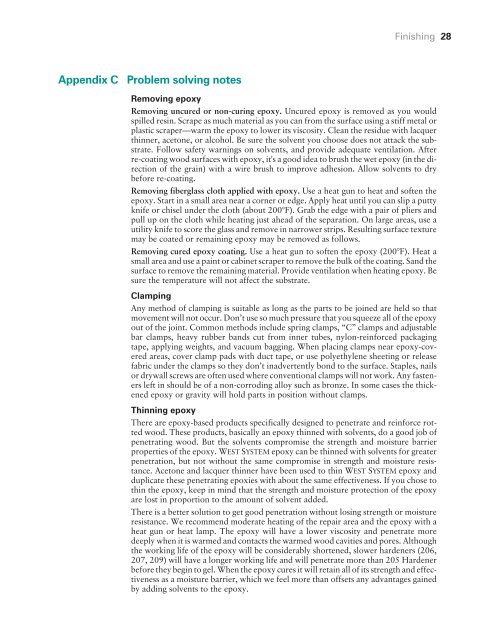Final Fairing & Finishing - WEST SYSTEM Epoxy
Final Fairing & Finishing - WEST SYSTEM Epoxy
Final Fairing & Finishing - WEST SYSTEM Epoxy
You also want an ePaper? Increase the reach of your titles
YUMPU automatically turns print PDFs into web optimized ePapers that Google loves.
Appendix C Problem solving notes<br />
<strong>Finishing</strong> 28<br />
Removing epoxy<br />
Removing uncured or non-curing epoxy. Uncured epoxy is removed as you would<br />
spilled resin. Scrape as much material as you can from the surface using a stiff metal or<br />
plastic scraper—warm the epoxy to lower its viscosity. Clean the residue with lacquer<br />
thinner, acetone, or alcohol. Be sure the solvent you choose does not attack the substrate.<br />
Follow safety warnings on solvents, and provide adequate ventilation. After<br />
re-coating wood surfaces with epoxy, it's a good idea to brush the wet epoxy (in the direction<br />
of the grain) with a wire brush to improve adhesion. Allow solvents to dry<br />
before re-coating.<br />
Removing fiberglass cloth applied with epoxy. Use a heat gun to heat and soften the<br />
epoxy. Start in a small area near a corner or edge. Apply heat until you can slip a putty<br />
knife or chisel under the cloth (about 200°F). Grab the edge with a pair of pliers and<br />
pull up on the cloth while heating just ahead of the separation. On large areas, use a<br />
utility knife to score the glass and remove in narrower strips. Resulting surface texture<br />
may be coated or remaining epoxy may be removed as follows.<br />
Removing cured epoxy coating. Use a heat gun to soften the epoxy (200°F). Heat a<br />
small area and use a paint or cabinet scraper to remove the bulk of the coating. Sand the<br />
surface to remove the remaining material. Provide ventilation when heating epoxy. Be<br />
sure the temperature will not affect the substrate.<br />
Clamping<br />
Any method of clamping is suitable as long as the parts to be joined are held so that<br />
movement will not occur. Don’t use so much pressure that you squeeze all of the epoxy<br />
out of the joint. Common methods include spring clamps, “C” clamps and adjustable<br />
bar clamps, heavy rubber bands cut from inner tubes, nylon-reinforced packaging<br />
tape, applying weights, and vacuum bagging. When placing clamps near epoxy-covered<br />
areas, cover clamp pads with duct tape, or use polyethylene sheeting or release<br />
fabric under the clamps so they don’t inadvertently bond to the surface. Staples, nails<br />
or drywall screws are often used where conventional clamps will not work. Any fasteners<br />
left in should be of a non-corroding alloy such as bronze. In some cases the thickened<br />
epoxy or gravity will hold parts in position without clamps.<br />
Thinning epoxy<br />
There are epoxy-based products specifically designed to penetrate and reinforce rotted<br />
wood. These products, basically an epoxy thinned with solvents, do a good job of<br />
penetrating wood. But the solvents compromise the strength and moisture barrier<br />
properties of the epoxy. <strong>WEST</strong> <strong>SYSTEM</strong> epoxy can be thinned with solvents for greater<br />
penetration, but not without the same compromise in strength and moisture resistance.<br />
Acetone and lacquer thinner have been used to thin <strong>WEST</strong> <strong>SYSTEM</strong> epoxy and<br />
duplicate these penetrating epoxies with about the same effectiveness. If you chose to<br />
thin the epoxy, keep in mind that the strength and moisture protection of the epoxy<br />
are lost in proportion to the amount of solvent added.<br />
There is a better solution to get good penetration without losing strength or moisture<br />
resistance. We recommend moderate heating of the repair area and the epoxy with a<br />
heat gun or heat lamp. The epoxy will have a lower viscosity and penetrate more<br />
deeply when it is warmed and contacts the warmed wood cavities and pores. Although<br />
the working life of the epoxy will be considerably shortened, slower hardeners (206,<br />
207, 209) will have a longer working life and will penetrate more than 205 Hardener<br />
before they begin to gel. When the epoxy cures it will retain all of its strength and effectiveness<br />
as a moisture barrier, which we feel more than offsets any advantages gained<br />
by adding solvents to the epoxy.
















